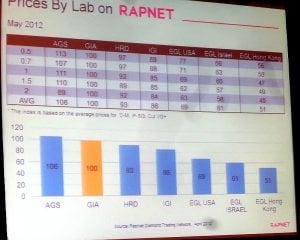Gypsy
Super_Ideal_Rock
- Joined
- Aug 8, 2005
- Messages
- 40,225
https://www.pricescope.com/wiki/diamond-grading From 2004 (maybe it's out of date?)
So I recently posted that EGL diamonds are not good values, and listed the reasons why for a poster and they were frustrated because they felt that my post (which is very similar to many of the standard EGL posts by RT prosumer posters) was contradicted by this article. And that the article was misleading.
I, for one, was just happy someone was actually reading our articles (YAY!) and trying to educate themselves, but also wanted to get your thoughts on whether this article does contradict the experiences and the threads we see on here where some of the EGL stones come back 3-5 grades off, or where the cut quality is bogus, or whatever.
Do we need to ask that this article be revised?
I personally think that people misunderstand what 'average' stats mean. To me it means that there will be the occasionally graded correct stone, and the occasional stone that is 5 grades off. So you average those two and you get that stones are 2.5 grades off. Which doesn't sound so bad, right? Well, it is if you are the guy with the stone that is 5 grades off. So perhaps the terminology needs to be defined better, or something, so that people understand that average means= your results may vary (and not in a good way).
The article says 2/3rds of the stone were this, and 2/3rd were that... so what are your thoughts on how helpful or misleading the article is?
ETA: I EDITED THE LINK!
So I recently posted that EGL diamonds are not good values, and listed the reasons why for a poster and they were frustrated because they felt that my post (which is very similar to many of the standard EGL posts by RT prosumer posters) was contradicted by this article. And that the article was misleading.
I, for one, was just happy someone was actually reading our articles (YAY!) and trying to educate themselves, but also wanted to get your thoughts on whether this article does contradict the experiences and the threads we see on here where some of the EGL stones come back 3-5 grades off, or where the cut quality is bogus, or whatever.
Do we need to ask that this article be revised?
I personally think that people misunderstand what 'average' stats mean. To me it means that there will be the occasionally graded correct stone, and the occasional stone that is 5 grades off. So you average those two and you get that stones are 2.5 grades off. Which doesn't sound so bad, right? Well, it is if you are the guy with the stone that is 5 grades off. So perhaps the terminology needs to be defined better, or something, so that people understand that average means= your results may vary (and not in a good way).
The article says 2/3rds of the stone were this, and 2/3rd were that... so what are your thoughts on how helpful or misleading the article is?
ETA: I EDITED THE LINK!





300x240.png)